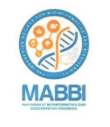Dihydrofolate Reductase (dfr) and Dihydropteroate Synthase (sul) Gene Mutations in Escherichia coli Trimethoprim-Sulfamethoxazole Resistance
Abstract
Escherichia coli is a rod-shaped bacterium with Gram-negative properties that colonizes the human digestive tract. Generally, E. coli is harmless, but can become pathogenic if it obtains additional virulence genes from other microorganisms through the mechanism of gene transfer (transformation), transfer by pili or pilus (conjugation), or gene transfer through bacteriophages (transduction). This pathogenic E.coli bacteria can cause enteric diseases such as diarrhea, urinary tract infections, and sepsis or meningitis.One of the empirical therapies in dealing with E. coli infection is the antibiotic trimethoprim-sulfamethoxazole. This antibiotics work by inhibiting the enzymatic reaction of bacterial folate synthesis at two successive stages in bacteria, so that this drug combination can provide a synergistic effect. Both combinations of antibiotics are reported to inhibit the bacterial synthesis of tetrahydrofolic acid, which is an important cofactor for the synthesis of thymidine and purines, the basic bases of DNA and RNA. Sulfonamides (sulfamethoxazole) are analogs of para-aminobenzoic acid (PABA) and compete with PABA to bind dihydropteroate synthetase (DHPS), thereby inhibiting dihydrofolate acid synthesis. Trimethoprim binds to dihydrofolate reductase (DHFR), thereby blocking the conversion of dihydrofolic acid to tetrahydrofolic acid. The mechanism of acquired resistance has often been identified, mainly due to mutational modifications in the genes that code for target enzymes. This can occur if there is resistance to the acquisition of the sul gene that codes for dihydropteroate synthetase so that it is not sensitive to sulfonamides, or it can occur in the dfr gene that codes for dihydrofolate reductase that is not sensitive to trimethoprim.
Full Text:
PDFDOI: https://doi.org/10.47007/ijobb.v8i1.204
Refbacks
- There are currently no refbacks.
| Indonesian Journal of Biotechnology and Biodiversity Published by: Publishing Department of Esa Unggul University Arjuna Utara No 9 Street Kebon Jeruk Jakarta - 11510 Indonesia | |









.png)

